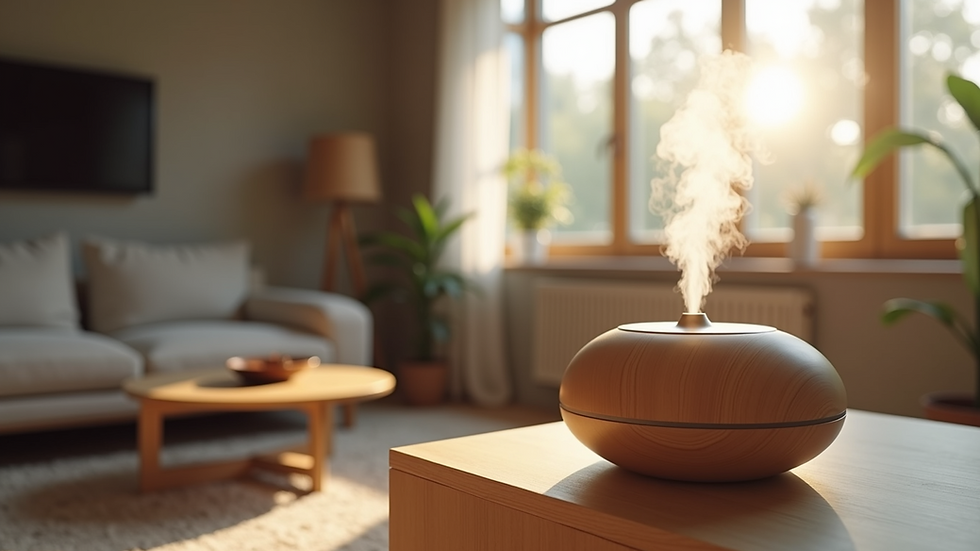Transform Your Space with Natural Aromas
- Astrid van Essen
- Aug 25
- 4 min read
Creating a welcoming and calming atmosphere in your home can be as simple as introducing natural aromas. These scents not only enhance the ambience but also have the power to influence mood, reduce stress, and promote relaxation. Whether you want to freshen up your living room, bedroom, or bathroom, natural aromas offer a subtle yet effective way to transform your space.
The Power of Natural Aromas in Your Home
Natural aromas come from essential oils, herbs, flowers, and other plant-based sources. Unlike synthetic fragrances, they provide a pure and authentic scent experience. Using natural aromas in your home can:
Improve air quality by reducing unpleasant odours
Create a soothing environment that supports mental well-being
Evoke memories and emotions linked to specific scents
Complement your interior design with a sensory dimension
For example, lavender is well-known for its calming properties, making it perfect for bedrooms. Citrus scents like lemon and orange can energise and uplift your kitchen or workspace. Eucalyptus is excellent for clearing the mind and refreshing the air in bathrooms.

Dried lavender flowers bring a calming, natural aroma to any room.
Incorporating natural aromas can be done through various methods, such as diffusers, candles, potpourri, or sachets. One popular choice is using a botanical home fragrance diffuser, which gently and evenly disperses essential oils throughout your space.
How to Choose the Right Natural Aromas for Your Space
Selecting the perfect natural aroma depends on the room’s purpose and your personal preferences. Here are some tips to guide your choices:
Consider the room’s function
Relaxation spaces: Opt for calming scents like chamomile, sandalwood, or vanilla.
Active areas: Choose invigorating aromas such as peppermint, rosemary, or citrus.
Social spaces: Use warm and inviting fragrances like cinnamon, clove, or jasmine.
Match aromas with your décor style
Rustic or bohemian interiors pair well with earthy scents like cedarwood or patchouli.
Modern and minimalist spaces benefit from fresh, clean aromas, such as eucalyptus or green tea.
Test scents before committing
Use small samples or testers to see how the aroma interacts with your space and personal taste.
Blend for uniqueness
Combine complementary scents to create a signature aroma. For example, lavender and lemon make a refreshing yet calming blend.

Diffusers help spread natural aromas evenly throughout your living space.
By thoughtfully selecting and combining natural aromas, you can tailor your home’s atmosphere to suit your lifestyle and mood.
What is the 30 50 20 rule for perfume?
The 30 50 20 rule is a guideline used in perfumery to balance the composition of a fragrance. It refers to the proportion of different scent notes that make up a perfume:
30% Top Notes: These are the initial scents you smell right after applying the perfume. They are usually light and fresh, such as citrus or herbal notes.
50% Middle (Heart) Notes: These form the core of the fragrance and emerge after the top notes fade. Floral, fruity, or spicy scents often make up this layer.
20% Base Notes: These are the lasting scents that linger on the skin for hours. They tend to be rich and deep, like musk, vanilla, or wood.
Understanding this rule can help you appreciate how natural aromas work in your home fragrance products. For instance, a diffuser blend might begin with bright citrus top notes, followed by floral middle notes, and conclude with a warm, woody base. This layering creates a complex and evolving scent experience that keeps your space smelling fresh and inviting.
Practical Ways to Use Natural Aromas in Your Home
Incorporating natural aromas into your home doesn’t have to be complicated. Here are some practical and easy methods:
1. Essential Oil Diffusers
These devices disperse essential oils into the air as a fine mist. They are safe, easy to use, and come in various styles to suit your décor. Simply add a few drops of your chosen oil and enjoy the scent.
2. Scented Candles
Choose candles made from natural waxes, such as soy or beeswax, that are infused with essential oils. They provide both light and fragrance, creating a cosy atmosphere.
3. Potpourri and Sachets
Place dried flowers, herbs, and spices in decorative bowls or fabric sachets to add a touch of elegance. These can be positioned in wardrobes, drawers, or around the house for a gentle scent boost.
4. Fresh Flowers and Herbs
Keep fresh blooms or potted herbs, such as rosemary, mint, or lavender, in your home. They add natural beauty and release subtle aromas.
5. Simmer Pots
Simmer water with natural ingredients such as cinnamon sticks, citrus peels, and cloves on the stove. This method fills your home with a warm, inviting scent.

Simmer pots release natural aromas that fill your home with warmth.
By experimenting with these options, you can discover the most effective way to incorporate natural aromas into your daily life.
Enhancing Well-being with Natural Aromas
Natural aromas do more than just make your home smell nice. They can have a positive impact on your health and well-being:
Stress Reduction: Scents like lavender and chamomile help lower cortisol levels and promote relaxation.
Improved Sleep: Using calming aromas in the bedroom can enhance sleep quality.
Mood Enhancement: Citrus and peppermint scents can boost energy and focus.
Respiratory Benefits: Eucalyptus and tea tree oils can help clear nasal passages and improve breathing.
To maximise these benefits, use natural aromas consistently and in appropriate amounts. Avoid overpowering your space, as too much fragrance can cause headaches or irritation.
Transforming your home with natural aromas is a simple and effective way to create a space that feels fresh, inviting, and nurturing. By choosing the right scents and delivery methods, you can enjoy the many benefits of nature’s fragrances every day. Whether you prefer the gentle mist of a diffuser or the warm glow of a scented candle, natural aromas bring a unique and personal touch to your living environment.



Comments